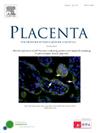内皮细胞对血管生成调节剂的反应强调了子痫前期血管功能障碍的代谢机制。
IF 2.5
2区 医学
Q2 DEVELOPMENTAL BIOLOGY
引用次数: 0
摘要
子痫前期(PE)的sFlt-1/PlGF比值升高直接损害内皮细胞(EC)代谢,导致乳酸脱氢酶(LDH)释放增加、脂质过氧化和线粒体功能障碍。正如循环sFlt-1与琥珀酸/甘氨酸水平之间的关联所证明的那样,这可能反映了与全身母体代谢失调相关的独特代谢物谱。方法:在体外ECs研究的基础上,对54例PE患者的血浆进行横断面病例对照研究。我们将血浆代谢物谱(通过基于核磁共振的代谢组学)与sFlt-1水平(通过酶联免疫吸附试验)联系起来。在机制上,我们研究了不同sFlt-1/PlGF比例对24 h后EC功能和代谢的影响,评估了细胞活力、细胞毒性、增殖、氧化应激相关损伤(脂质过氧化和硝化)以及实时线粒体功能和代谢谱。结果:在PE孕妇中,循环sFlt-1水平与琥珀酸和甘氨酸水平呈正相关,但与乳酸或葡萄糖水平无显著相关性。在体外,随着sFlt-1/PlGF比率的增加,EC损伤(LDH释放)和氧化应激相关损伤(4-羟基-2-烯醛)呈剂量依赖性增加。高sFlt-1/PlGF比率也增加了线粒体备用呼吸能力,提示代偿机制。代谢组学显示,暴露于不同sFlt-1/PlGF比率的ec中代谢重编程,乳酸、琥珀酸、葡萄糖和甘氨酸水平显著改变。讨论:这些相关性和体外变化表明,在内皮细胞中,sFlt-1/PlGF比率、氧化应激相关损伤和代谢重编程之间存在机制联系,这可能是治疗的靶点。此外,鉴定琥珀酸盐和甘氨酸作为与sFlt-1水平和sFlt-1/PlGF比率相关的关键代谢物可能为疾病风险分层和/或监测PE进展提供新的生物标志物。本文章由计算机程序翻译,如有差异,请以英文原文为准。
Endothelial responses to angiogenic modulators highlight metabolic mechanisms underlying vascular dysfunction in preeclampsia
Introduction
An elevated sFlt-1/PlGF ratio in preeclampsia (PE) directly impairs endothelial cell (EC) metabolism, leading to increased lactate dehydrogenase (LDH) release, lipid peroxidation, and mitochondrial dysfunction. This may reflect a distinct metabolite profile which correlates with systemic maternal metabolic dysregulation, as evidenced by the association between circulating sFlt-1 and succinate/glycine levels.
Methods
A cross-sectional case-control study was performed on plasma of PE patients (n = 54) in addition to an in vitro study using ECs. We correlated plasma metabolite profiles (by nuclear magnetic resonance-based metabolomics) with sFlt-1 levels (by Enzyme-Linked Immunosorbent Assay). Mechanistically, we examined the impact of varying sFlt-1/PlGF ratios on EC function and metabolism after 24 h, assessing cell viability, cytotoxicity, proliferation, oxidative stress-related damage (lipid peroxidation and nitration), and real-time mitochondria function and metabolic profiles.
Results
In pregnant women with PE, circulating sFlt-1 levels positively correlated with succinate and glycine levels, but not significantly with lactate or glucose. In vitro, as sFlt-1/PlGF ratios, increased EC damage (LDH release) and oxidative stress-related damage (4-hydroxy-2-nonenal) increased dose-dependently. High sFlt-1/PlGF ratios also increased mitochondrial spare respiratory capacity, suggesting a compensatory mechanism. Metabolomics revealed metabolic reprogramming in ECs exposed to varying sFlt-1/PlGF ratios, with significant alterations in lactate, succinate, glucose, and glycine levels.
Discussion
These correlations and in vitro changes suggest a mechanistic link between sFlt-1/PlGF ratios, oxidative stress-related damage, and metabolic reprogramming in ECs, which could be targeted for therapeutics. Furthermore, the identification of succinate and glycine as key metabolites associated with sFlt-1 levels and sFlt-1/PlGF ratios may provide novel biomarkers for disease risk stratification and/or monitoring PE progression.
求助全文
通过发布文献求助,成功后即可免费获取论文全文。
去求助
来源期刊

Placenta
医学-发育生物学
CiteScore
6.30
自引率
10.50%
发文量
391
审稿时长
78 days
期刊介绍:
Placenta publishes high-quality original articles and invited topical reviews on all aspects of human and animal placentation, and the interactions between the mother, the placenta and fetal development. Topics covered include evolution, development, genetics and epigenetics, stem cells, metabolism, transport, immunology, pathology, pharmacology, cell and molecular biology, and developmental programming. The Editors welcome studies on implantation and the endometrium, comparative placentation, the uterine and umbilical circulations, the relationship between fetal and placental development, clinical aspects of altered placental development or function, the placental membranes, the influence of paternal factors on placental development or function, and the assessment of biomarkers of placental disorders.
 求助内容:
求助内容: 应助结果提醒方式:
应助结果提醒方式:


